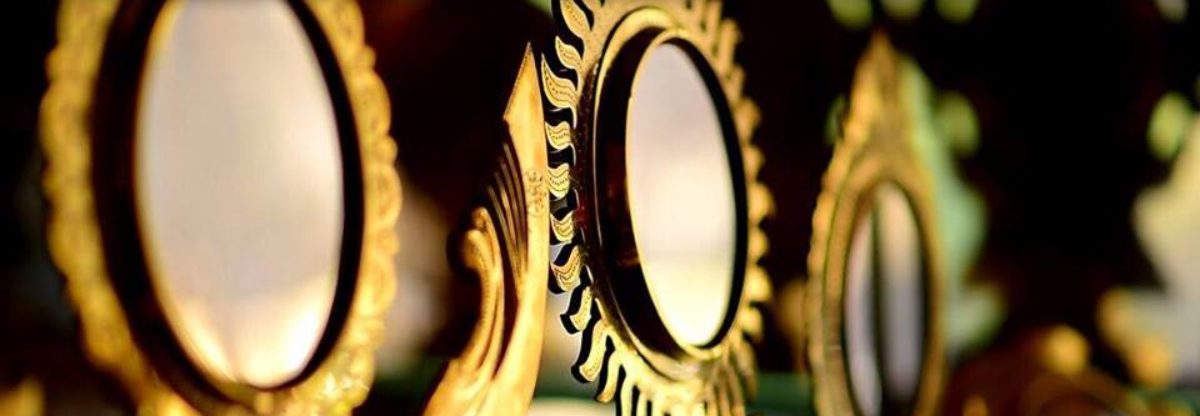The Aranmula mirror is unique. Unlike your ordinary mirror which is made of glass with a coating of silver nitrate, this one is crafted purely from metals — a special alloy of copper, tin, silver and some secret ingredients. The exact composition of these metals is known only to the few families in, of course, Aranmula, a village in Kerala’s Pathanamthitta district. While a regular mirror reflects images from its coated layer, the highly polished Aranmula does so directly from its surface. No distortions in the images, claim the makers who are extremely skilled artisans.
The mirror enjoys limited fame. The British museum is said to have a 45-cm long Aranmula and well-to-do Keralites keep one for its snob value (it is expensive) and for its supposed ability to shower good fortune on the owners. Even in these competitive times, the producers, a handful of families who have been making this mirror for generations since the 18th century, appear to doing well, but are clearly dependent on exports to keep their skills alive. They have become more sophisticated with their marketing and have set up a couple of websites to reach out to a wider market. All the same, it was a bit of a surprise to see the Aranmula, faintly remembered as a lost family heirloom, leap out of a list of over 60 products that have entered the Geographical Indications (GIs) registry in India.
GIs are in a way a kind of intellectual property right (IPR) instituted by the WTO that does more than provide trademark protection, allowing producers to get market recognition and often a premium price. It is an IPR that is not so much about the what but the where of a product although quality and authenticity are very much a concern. The major difference between a patent and GI is that while the former protects contemporary innovation, GI rewards the past and helps to preserve cultural traditions by protecting community knowledge. In essence, GI identifies a product as originating from a particular place, and whose quality, reputation or other characteristics are attributable to its geographical source.
In recent months there has been practically a stampede for GI registration in India. Unlike the developed countries which use it primarily for food products (Champagne, of course, and things like Parma Ham), India has extended GI protection to products across the spectrum, from handicrafts to flowers and spices. Thus the Aranmula mirror, along with assorted silks, saris, textiles and embroidery styles, joins soaps, incense, different varieties of jasmines, several strains of rice, tea, betel leaf, pepper and chillies to get the GI tag.
The GI Registry at Chennai, where right-holders can register their products, is getting inundated. The question, however, is how much of a protection a GI offers. For one, other WTO members are not obliged to ensure the same kind of protection to all Indian GIs because there is a problem of hierarchy. Although TRIPS has a single definition for all GIs, it has authorised a two-level system of protection: one, a general protection under Article 22, and the other, a higher level under Article 23 that is applicable only to wines and spirits.
According to some experts, Article 22 is not good enough. It is simply a law against unfair trade practices and for consumer protection and is not really for IPR protection. A producer not belonging to a specific geographical region could still use the GI as long as the product’s true origin is indicated on the label. In other words, an Aranmula mirror could be turned out from, say, Houston in Texas, thus allowing an American producer to free ride on the reputation and market goodwill created by Keralite artisans over two centuries. Tellicherry pepper and Udupi jasmine thus far are not in the same class as wine from Champagne.
As with several other issues, GI is a bitterly contested IPR issue in the WTO with Europe and parts of the developing world ranged against the likes of Australia and the US, a kind of old world versus the new world confrontation. It is unlikely that those fighting for extension of Article 23 protection will have it easy. But before it prepares to take on this global battle India needs to have in mind, if not in hand yet, some strategies on marketing and promoting its GI. These products for the most part are unknown and their commercial potential neither researched nor analysed.
And perhaps, the GI Registry in Chennai needs to apply more stringent yardsticks. As states get more competitive to include as many of their products in the registry, it appears have become a free-for-all. Does a Coimbatore wet grinder, the ubiquitous stone contraption used in south India to grind grains, qualify for GI?
